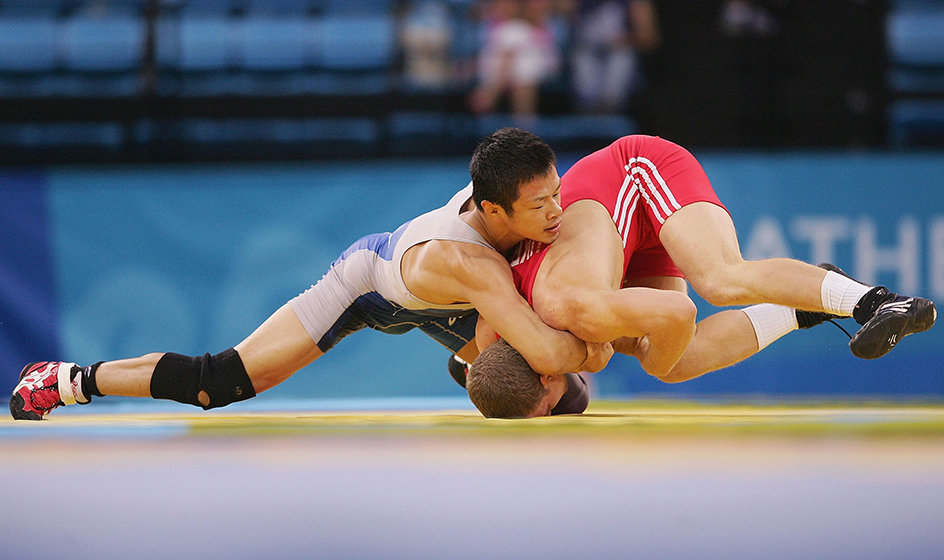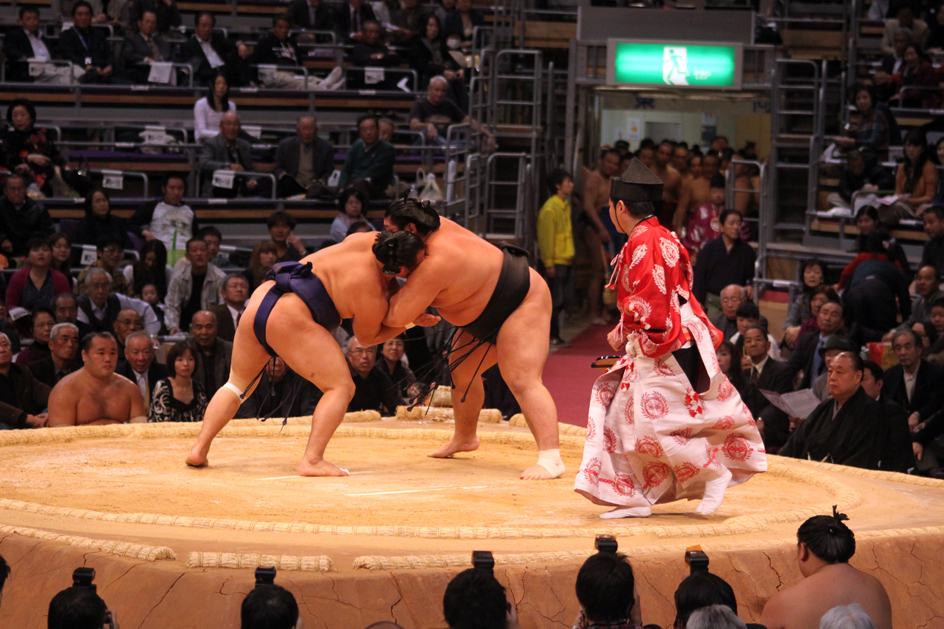Wrestling << REHS lihng >> is a sport in which two opponents try to pin (hold) each other’s shoulders to a mat on the floor. Wrestlers use maneuvers called holds to grasp their opponents and control their opponents’ position and movements.
Successful wrestling demands strength, speed, and coordination. It also requires balance, flexibility, physical conditioning, and knowledge of body leverage. A clever wrestler can often defeat a stronger and heavier opponent.

There are more than 50 kinds of wrestling. Each has its own rules. Some kinds do not require a pin for victory. In Japanese sumo, for example, a wrestler tries to throw his opponent to the ground or force him outside a 15-foot (4.6-meter) circle.

This article discusses amateur wrestling, which is a popular sport in clubs and schools in many countries. Students in pre-elementary school through college take part in wrestling matches at events called tournaments or duals. Tournaments group individuals from opposing teams based on age and weight to create a bracket. Duals are competitions in which two teams compete against each other. Individuals are paired based on weight division or classes.
National and world championship competitions are held annually. Every four years, wrestlers compete in the Summer Olympic Games.
The Fédération Internationale des Luttes Associées (FILA) governs international amateur wrestling. USA Wrestling governs the sport in the United States. Amateur wrestling traditionally is a sport for boys and men. However, FILA established separate competition for women’s freestyle wrestling in 1988.
Chief forms of wrestling.
The two most popular forms of wrestling in the world are Greco-Roman and freestyle. Freestyle is the older of the two forms and the most popular in North America. It resembles the style practiced by the ancient Greeks. The Greco-Roman style developed after the Romans conquered Greece and modified the Greeks’ style. It is more popular in Europe. International competition, including the Olympics, is held in both freestyle and Greco-Roman.
Most of the rules and procedures in the two styles are the same. The main difference concerns the use of the legs. In freestyle, wrestlers may attack an opponent’s legs. They may use their own legs to grasp an opponent’s arms or legs, or to trip or tackle an opponent’s legs. In Greco-Roman, wrestlers cannot attack an opponent’s legs or attack with their own legs. The legs may be used only for support. Thus, upper body strength and leverage are the chief factors.
Some international wrestling meets feature competition in a style called sambo, or sombo. Sambo is a blend of several forms of wrestling and the martial arts, especially judo. Some international meets now feature beach wrestling. A beach-wrestling match takes place on sand inside a circle that is approximately 20 feet (6 meters) in diameter.
High school and intercollegiate wrestling.
There are 14 weight classes in high school wrestling in the United States. There are 10 intercollegiate classes. Wrestlers may weigh no more than the weight in their class. However, they may weigh less. High school weight classes range from 103 pounds (46.7 kilograms) to a heavyweight class of no more than 285 pounds (129.3 kilograms). Intercollegiate classes range from 125 pounds (56.7 kilograms) to no more than 285 pounds.
High school matches are divided into three periods of two minutes each. Intercollegiate matches begin with a three-minute period. The remaining two periods last two minutes each. Matches take place on a cushioned mat with a wrestling area at least 32 feet (9.75 meters) square or 32 feet in diameter. At least 5 feet (1.5 meters) of mat must surround the wrestling area. The first period begins with the wrestlers standing and facing each other in neutral position. The second period begins with one wrestler having a choice of top position, bottom position, or neutral position. The wrestler also can defer the choice to the opponent so as to have the choice at the beginning of the third period. For a description of these positions, see the illustrations of holds and positions in the Wrestling article in the print version of World Book.
Wrestlers receive points for skillfully executing various holds and maneuvers. They may also win points if their opponent commits a technical error, uses an illegal hold, or breaks a rule. The match ends when a wrestler gains a fall by holding his or her opponent’s shoulders to the mat. The opponent’s shoulders must be held for two seconds in a high school match. The time is one second in an intercollegiate match. If no fall occurs, the wrestler with the most points wins. If the match ends with one wrestler outscoring the opponent by 8 to 14 points, the winner earns a major decision. If a wrestler leads by more than 15 points at any time during the match, the match ends immediately as a technical fall.
International competition.
FILA divides wrestlers into four categories based on age. They are schoolboys (14 and 15 years), cadets (16 and 17), juniors (18 to 20 ), and seniors (20 and older). There are separate weight classes in each category. International competitions are conducted in freestyle and Greco-Roman. The senior division competes in the Olympic Games.
Schoolboy and cadet matches are divided into three periods of 90 seconds each. Junior and senior division matches consist of three periods of 2 minutes each. At the end of each period, a winner is declared. The wrestler who wins two periods is declared the match winner. If one wrestler wins the first two periods, the third period is not wrestled. Three officials direct each match. At least two officials must agree on a decision.
History.
Wrestling dates back to prehistoric times. In French caves, drawings and carvings 15,000 to 20,000 years old show people wrestling. Wrestling was introduced into the Olympic Games in Greece in 708 B.C.
